Media Review Template
Title plus author’s full name and affiliation
Abstract (not more than 200)
The abstract is a crucial element of any academic article; it not only
summarizes your paper but also helps it reach the right audience. Your abstract
should be written in both English and Persian; it should appear in block
format, single spaced and justified. The abstract should include: 1) a brief
(one or two sentence) introduction; 2) the media selected for the review and
the significance/ purpose of the review/ selection; 3) major findings and; 4)
recommendations.
Introduction (approximately 450 words)
The introduction should give a broad view of the field of educational
technology with a focus on the role of technology in second/ foreign language
education. It then narrows the focus on the media selected for the review and
how and why the review can contribute to second/ foreign language learning and
teaching.
Description (approximately 550 words)
The authors need to describe the media tool as accurately as possible,
preferably using photos and graphics that make the description engaging and
interesting to read. The description should tell the readers about where they
can find/download the media, what its different sections are and what the
features and purposes/functions of each section are, etc.
Evaluation (approximately 350 words)
In this part the overall value of the media review and its contribution to
second/ foreign language is given, followed by its strengths and/or possible
weaknesses. The authors can offer their own and research-supported suggestions
on how those shortcomings can be removed or taken care of.
Conclusion (Approximately 250 words)
The review ends with a conclusion that summarizes the main points and
make specific recommendations on the use of the media for second/ foreign
language learning and teaching.
References
References should be up to date and written in APA style. The number of
references should not exceed 10.
HelloTalk: A Language Exchange App
on Your Smartphone
Musa Nushi, Department of English Language and Literature, Shahid
Beheshti University
Tehran, Iran
Hossein Makiabadi, Department of English Language and Literature,
Ferdowsi University of Mashhad, Iran
Abstract
Not being able to physically attend language classes, high fees of
getting a second language (L2) education, technological improvements, and the
variety-demanding nature of modern man have considerably increased the tendency
towards the usage of mobile-assisted language learning (MALL) applications.
Thanks to the MALL technology, many apps have already been launched for a more
meaningful learning. Meanwhile, apps with larger user bases are the first
choice of the majority of L2 learners, since they provide a more social
atmosphere for the users to communicate and share ideas with one another;
besides, such apps offer a creative and joyful way of learning which is really
popular with young learners. An appropriate prototype of such apps is
HelloTalk, and the present paper has been written to review its facets and
features.
Key Words: Mobile-assisted language learning, HelloTalk, meaningful
learning
Introduction
The pivotal role technology can play in second language (L2) pedagogy is
undeniable. Nunan (2010) has specified four main roles that technology can play
in the language classroom: a carrier of content, an instructional practice
tool, a learning management tool, and a communication tool. Technology is a
carrier of content in that it provides learners with access to authentic and
pedagogic written input as well as information about the language subskills.
Technology acts as an instructional tool because they allow learners to carry
out various spoken and written exercises. As a learning management tool, it
helps teachers and learners to structure and evaluate their learning process.
The use of proprietary software such as Moodle, for instance, makes it possible
for teachers to perform effective learning management tasks.The fourth function
of technology relates to the fact that technology can enable language learners
to interact with native speakers of the target language all around the world.
L2 teachers can apply technological innovations to support their classroom
practice: first, technology promotes a deep rather than surface approach to
learning (Biggs & Telfer 1993); second, it stimulates active,
constructivist learning rather than straight knowledge transfer (Weasenforth et
al., 2002), third, it fosters students’ awareness of discourse-related aspects
of communication (Davis &Thiede, 2000), and fourth, it allows students to share perspectives and
experiences, to establish relationships, and to seek assistance (Chong, 1998).
Today, one of the main concerns of L2 learners is to have quick and easy
access to a wide variety of materials which can help them learn a language.
Hand-held devices, specifically mobile phones, fit into students’ pockets, so
they can use them almost everywhere, at any time, and for any kind of learning
(Prensky, 2005). In other words, technological devices carried easily by
learners provide ubiquitous learning (Godwin-Jones, 2011). Mobile phone has
become so prominent and popular almost all over the world. It has brought about
a different type of L2 learning called Mobile Assisted Language Learning
(MALL). MALL is considered as an efficient language learning tool used by both
teachers and learners. It is a teaching method which uses mobile phone
technology in order to encourage learner autonomy as it enables students, after
they receive initial scaffolding by the teacher, to take responsibility for
their own learning (Park, 2011). Another advantage of the use of mobile phones
in L2 pedagogy is that students can expose themselves to the language outside
of the classroom (Geddes, 2004). It, in fact, promotes a learner-centered
teaching method. In addition, MALL creates collaborative learning conditions as
learners can carry out tasks in pairs or in groups using their mobile phones
(Lan, Sung, & Chang, 2007).
However, teachers should be aware of the fact that MALL can jeopardize
successful L2 learning. One reason is that students may have a myriad of
applications (e.g., dictionaries, translators, …) installed on their phones
which can assist them when doing exercises or tasks. That is, they may rely on
the applications rather than their own knowledge. Another reason may be that
only a few tasks can be carried out by using mobile phones (Stockwell&
Hubbard, 2013). Tasks required to be performed by more advanced learners may
not be easily provided on the phones. Students may also not take learning
seriously when using their phones because they usually use their devices for
non-educational purposes. Moreover, teachers need to make sure all the students
own mobile phones capable of performing smart functions and tasks because
traditional devices may not be sophisticated enough to be used for educational
aims. Finally, as pointed out by Nushi and Jenabzadeh (2016),many of the
language learning applications “have been developed by people outside of the
field of second language pedagogy and their effectiveness cannot and should not
be taken for granted, (p. 30). This review, therefore, focuses on one mobile
language learning application, Hello Talk, and explores the learning
possibilities the application offers to L2 learners.
Detailed description
Hello Talk, with the rating of 4.3 on Google Play, is a popular language
learning app on the market, the team of which is based in Hong Kong and
Shenzhen, China. This application covers almost all the languages in the world
including English, Japanese, Korean, Spanish, French, Mandarin, Portuguese,
German, Italian, Russian, Arabic, and many other languages. Its main purpose is
to connect language learners directly to native speakers and the target culture
in order to facilitate language learning. This app has many different options,
yet in order to access them without limitations, the premium version should be downloaded
due to the limitations of its free version. Although the app is not fully free,
its user base is comparatively large; according to HelloTalk website, there are
over 7 million members currently using this app.It is favorable that this app
is accessible to both Android and iOS users.
The first step one should take after installing HelloTalk is to fill out
their profile (see Figure 1). As soon as they are done with this task, they are
able to start searching for language partners through making and accepting
requests. HelloTalk users have access to an amazing global language exchange
community. This app allows learners to find language partners, chat with them,
send voice messages to them, or call them. It is worth noting that although
there are some websites which enable individuals to look for appropriate
conversation partners through platforms such as Skype, they are not effective
due to their small user base in comparison to apps like HelloTalk.
Figure 1. User profile
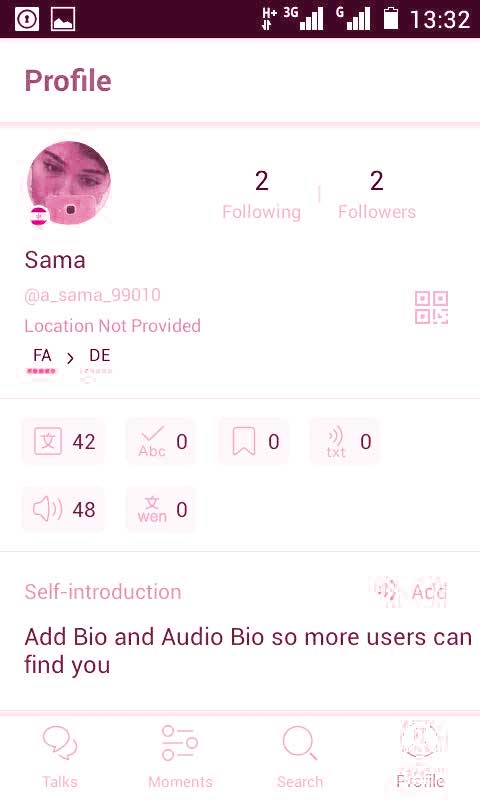
HelloTalk offers a variety of desirable features to language learners
all over the world, including:
• Voice messaging
• Text chat
• Camera/ photo share
• Doodle share (drawing in the app; see Figure 2)
• Smileys
• GPS location share
• Specific language learning features: Translation, transliteration, and
voice recognition to help learners write/speak in their target language.
Figure 2. Doodles in HelloTalk

All those features serve as language learning tools and suitable options
for users to make rapport with other members of the language community. Some of
the features are really attractive. For instance, the voice recognition system
built in the app is capable of converting the speech to text. Moreover, this
app gives the chance of chatting in several languages at the same time without
changing the target language in the settings.
Another salient feature of this app, as displayed in Figure 3, is a
toolbar which appears on the screen by tapping once on the text messages and
has a number of options. The options are copying the text message, bookmarking
it as a favorite, adding it to the personal notebook, revising it, reading it
out loud, translating, and transliterating it.
Figure 3. Toolbar and its options
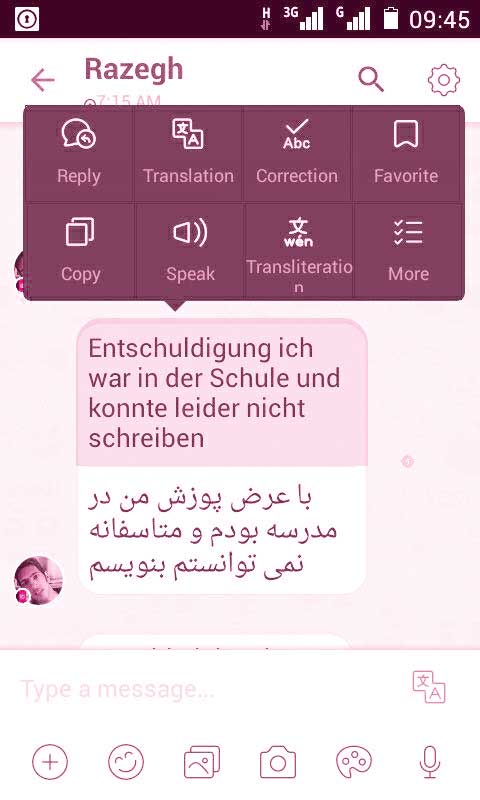
The most challenging obstacle one should overcome in learning a new
language is actually starting a conversation and continuing it (Richards,
2016).There is a Moments part defined in HelloTalk app, shown in Figure 4,
which can help learners a great deal with this challenge. This option enables
learners to share some posts and write comments on each other’s posts. It helps
them get a whole lot of extra exposure to the target language and creates an
immersion environment.This feature might find its grounds in Suggestopedia and
its peripheral learning principle introduced by Lozanov (1978) who believed
language learners can grasp information easily and effortlessly when it is
apprehended as a part of the environment rather than the instructional
materials.
Figure 4. Moments
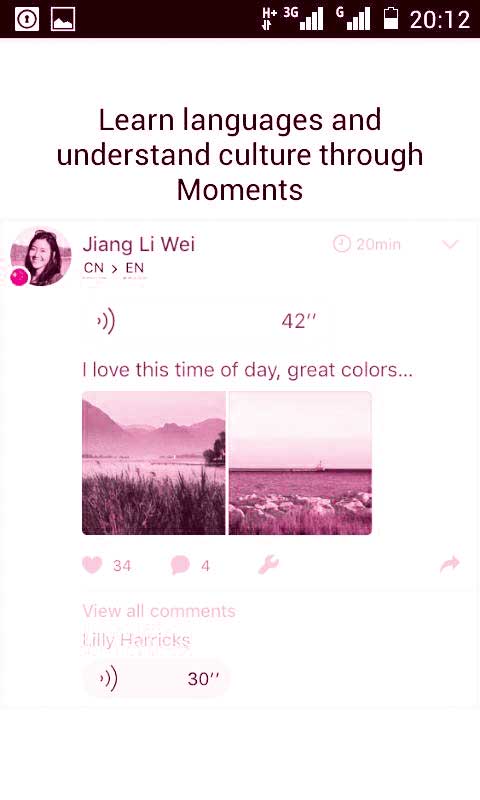
As it is indicated in Figure 5, the settings section and especially the
search engine of this app is precise and customizes your searches based on your
preferences. Furthermore, learners can even change the reading speed of the
computerized voice of the app in this section. Notifications, chat, and backup
settings are also available in this app,features offered by many other language
learning apps such as Speaky.
Figure 5. Refining search engine and chat settings
Strengths
In order to have real-life connections, HelloTalk allows its users to make
free phone calls for a better and friendlier language learning experience.
Through this feature, learners become familiar with casual and informal talk of
the target language which is an important skill in a second language.One of the
most prominent features of this app is the automatic translation feature which
helps to keep conversations going. The Romanized pronunciation is additionally
useful especially in case of those languages which do not use Latin alphabet
such as Chinese. Figure 6 shows that feature.Once more, it should be pointed
out that all these features are thoroughly available in the premium version of
the app, and the free version has limitations in these cases.
Figure 6. Transliteration feature
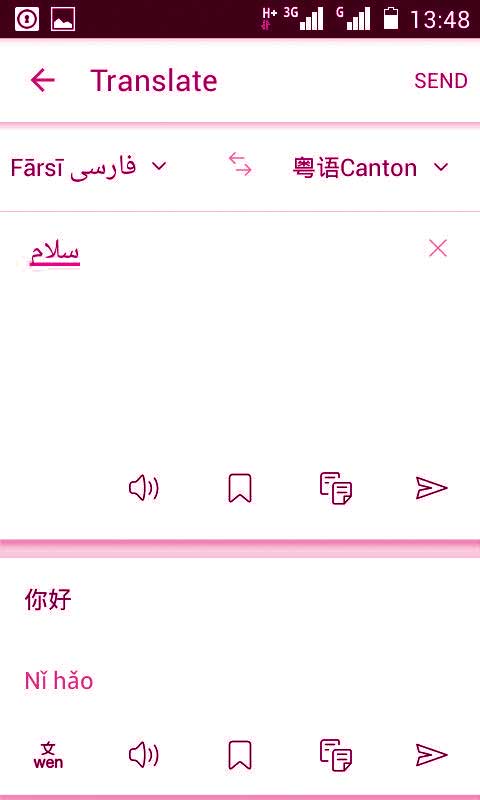
Another feature of this app is the demonstration of the users’
nationality, local time and location under their profile picture. This feature
lets users know whether it is an appropriate time to start chatting with their
conversational partners.Of course, the app also allows users to hide details
like their age or location in the advanced privacy settings if they wish to
keep such details private.What is particular about this app is its terrific
system of on-the-text correction. As can be seen in figure 7, such a system
keeps the learner focused on the language and its usage.
Figure 7. On-the-text correction
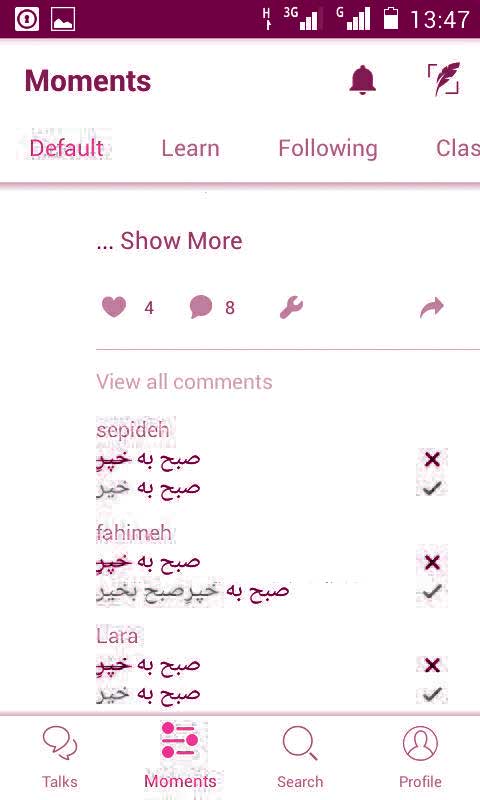
To ensure that the chance of learning of a party is equal to that of the
other one, the app provides a distinctive “Language Exchange” environment which
counts the number of characters or the amount of time spent (e.g. 500-1000
characters or 5 minutes) in one language. When either the number of characters
or the time reaches the limit, the app recommends to switch languages so that
there will not be a one-sided conversation to the benefit of just one of the
parties.Finally, HelloTalk seems to be a secure app which respects individuals’
privacy. The figure below shows the different privacy and security features in
this app.
Figure 8. Safety and privacy in Hellotalk
Weaknesses
The most considerable shortcoming of this app which needs urgent
attention is the lack of motivational system to encourage learners to continue
language learning with this app. Owing to the fact that there are basically no
alerts from the HelloTalk team, users, especially those with less intrinsic
motivation, might not attempt to regularly involve themselves in chatting in
another language. Similar to many good mobile language learning applications,
HelloTalk is not 100% free. The price of VIP membership (i.e., the paid
version)is fairly high as displayed in Figure 9, additionally it could be
considered really unfair to have to pay for practicing any other language pairs
beyond the first one.
Figure 9. VIP membership
prices
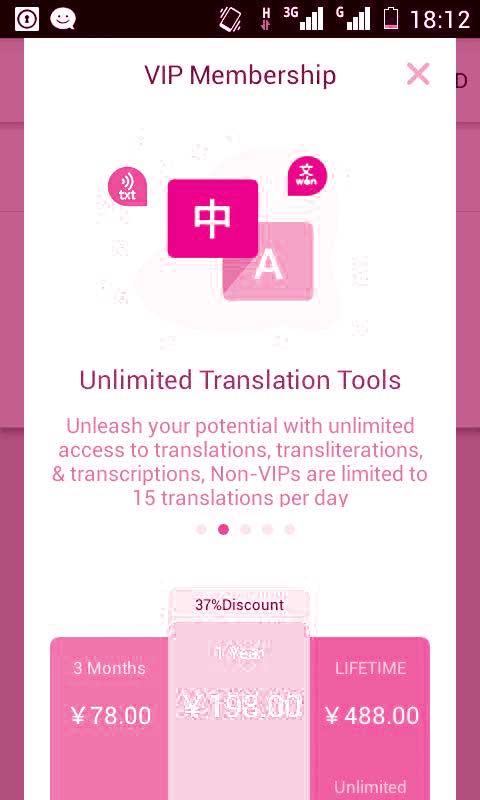
Unfortunately, no feedback is given to the learners on their progress
status while they are chatting in the community. Moreover, there are basically
no formal training in terms of learning a new language. That is, the produced
grammar, phonology, vocabulary, and so on are only monitored by native and/or
native-like peers in the community. To the best knowledge of the authors, such
downsides not only reduce the level of learners’ motivation but also leave the
learners helpless in determining their appropriate language level. Hence, the
HelloTalk expert team need to obviate this need.
Conclusion
HelloTalk is an effective language learning tool especially for the
young generation due to its purely social environment. The great number of
languages this app covers and the miscellaneous collection of its features form
an enjoyable atmosphere for learning a new language. Providing language
learners with almost every type of facility for rapid, effective, and
meaningful learning is an admiring task which has been performed by the
professional HelloTalk team. Some noticeable features of this app are
on-the-text corrections, automatic translation, and transliteration that have
introduced the app as an outstanding one. Similar to other language learning
apps, HelloTalk also suffers from a number of limitations. The non-free VIP
membership for complete translation and transliteration packages, no reports
and/or feedback on learners’ development, and no alerts or monitoring as a
stimulus for users seem to be the app’s shortcomings. In brief, it is fair to
state that HelloTalk is a popular and widely-used language learning app,
drawing the attention of a growing community. HelloTalk team is demanded to
alleviate the app’s minor problems to boost its language learning potential as
much as possible.
References
Biggs, J. & Telfer, R. (1987). The process of learning. Sydney:
Prentice Hall.
Chong, S. -M. (1998). Models of asynchronous computer conferencing for
collaborative learning in large college classes. In Bonk, C. J. and King, K. S.
(Eds.). Electronic Collaborators, (pp. 157–182). Mahwah, NJ: Erlbaum.
Davis, B. &Thiede, R. (2000). Writing into change: Style shifting in
asynchronous electronic discourse. In Warschauer, M. and Kern, R.
(Eds.),Network-based language teaching: Concepts and practice(pp 87–120).
Cambridge: Cambridge University Press.
Geddes, S. J. (2004). Mobile learning in the 21st century: benefit to
learners. Retrieved from
http://knowledgetree.flexiblelearning.net.au/edition06/download/geddes.
Godwin-Jones, R. (2011). Emerging technologies: Mobile apps for language
learning. Language Learning & Technology, 15(2), 2-11.
Lan, Y.-J., Sung, Y.-T., & Chang, K.-E. (2007). A
mobile-device-supported peer-assisted learning system for collaborative early
EFL reading. Language Learning & Technology, 11(3), 130-151.
Lozanov, G. (1978). Suggestology and outlines of suggestopedia. Hodder
Headline Group. New York.
Nunan, D. (2010). Technology supports for second language learning. In
Peterson, P., Baker, E., & McGaw, B. (Eds.), International Encyclopedia of
Education (pp. 204–210). London, UK: Elsevier.
Nushi, M., &Jenabzadeh, H. (2016). Busuu: The
Mobile App. The TESL Reporter,
49(2), 30-38.
Park, Y. (2011). A pedagogical framework for mobile learning:
Categorizing educational applications of mobile technologies into four types.
The International Review of Research in Open and Distributed Learning, 12(2),
78-102.
Prensky, M. (2005). What can you learn from a cell phone? Almost
anything! The Innovate Gateway 1 (June/July). Retrieved from
http://www.innovateonline. Info/index.php?view=article&id=83
Richards, O. (2016). HelloTalk App Review – Connect with native speakers
around the world. Retrieved from
http://www.iwillteachyoualanguage.com/hellotalk-app-review/
Stockwell, G., & Hubbard, P. (2013). Some Emerging Principles for
Mobile-assisted Language Learning. The International Research Foundation for
English Language Education. Retrieved from
http://www.tirfonline.org/english-in-the-workforce/mobile-assisted-language-learning.
Weasenforth, D., Biesenbach-Lucas, S., & Meloni, C. (2002).
Realizing constructivist objectives through collaborative technologies:
Threaded discussions. Language Learning and Technology 6(3), 58–86.